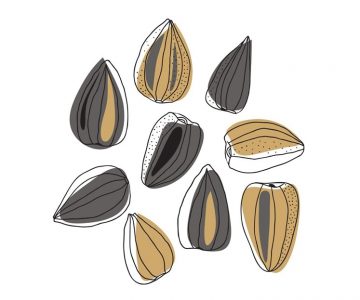The Garden of Erin
Teens get the dirt on food and farming at Erin District High School.
Bright green beet and radish tops, juicy-looking heads of lettuce and a tangle of cilantro leaves soaked up the sun in a raised garden bed. Another bed nearby was home to leafy purple kale, rows of green onions, clumps of parsley and thriving tomato plants. It was hard to believe we were on the grounds of a high school, not in the kitchen garden of a swish restaurant. In just a few weeks, the crops soaking up last year’s late May sunshine would be harvested by a gaggle of teenagers before the final bell rang to mark the beginning of summer vacation.
Just a few months earlier, the garden had been the unused, overgrown front field of Erin District High School on Boland Drive in Erin village. Then it became the Everdale and EDHS Farm Project.
Like the big reveal on a home reno show, the impressive transformation was the result of years of discussion and planning that culminated in six weeks of site preparation, a collaboration between the high school and Everdale, an organic teaching farm near Hillsburgh. The idea? To create an antidote to Big Food and agribusiness and connect kids to wholesome, real food.
As I watched more than a dozen students buzz around the raised beds over the lunch hour one day last spring, it certainly looked as if they were having a blast. The kids often eat lunch together before getting down to garden tasks. Some asked the grownups for direction while others confidently got to work. One student explained to another how to identify a sucker growing in the joint of a tomato plant and the best way to nip it off. Together the students watered plants and arranged covers over hoops to keep some plants warm ahead of an impending chilly night – all with a great deal of laughter.
Amid the lively chatter, senior student Raven Lacombe said she had been involved in the farm project from the beginning and felt an immediate connection to what the program was trying to convey. It even changed her eating habits. “It taught me a lot about organic agriculture, and after growing these vegetables, I have become a vegetarian,” Raven said, as she transferred soil from a wheelbarrow to one of the raised beds.
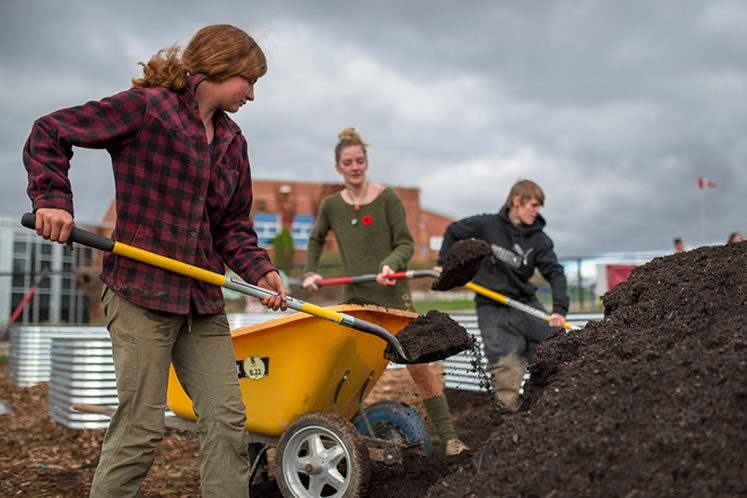
Digging in the dirt. Student Georgia Lavers (centre) and Everdale staffers Jordan Tilley (left) and Sam Nicholls moved mulch for the school’s new raised vegetable beds last fall as part of the Everdale and Erin District High School Farm Project. Photo by James MacDonald.
Laying the groundwork
The farm project began to take shape in the fall of 2016 when Everdale – founded in 1998 and one of Canada’s oldest teaching farms – applied for and received both an Ontario Trillium Foundation Seed Grant and funding from TD Friends of the Environment for a community project.
Karen Campbell, one of Everdale’s directors, joined a team of school faculty, students and some community members to brainstorm ways of creating a productive teaching farm on previously neglected land surrounded by an asphalt parking lot. During one of the planning sessions, the team used a 10×10 foot piece of paper to represent the quarter acre of land they had to transform. The only direction? Dream big.
Everdale was keen to commit to a project that complements the “great learning that is already happening around food and the environment at EDHS,” said Karen. “We are happy to continue to help guide the farm project and work in tandem with the school to see the farm reach its potential.”
The team opted to use raised beds made of galvanized steel rather than digging in the existing ground so they could more effectively control soil quality by adding compost and new soil. The new soil also helped keep weeds down. The vision included a seating area where all students would be welcome to relax and eat lunch. In the future they hope to plant fruit trees, creating an idyllic retreat from the sometimes boisterous pace of high school life.
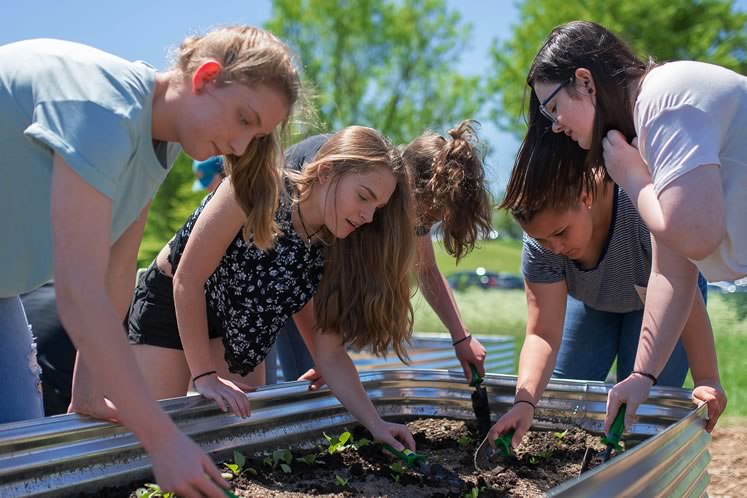
A sunny spring day gets students Sarah Baker, Megan Crane, Maggie Claus, Mikayla Clarke and Amanda Cote outside to plant fast-growing crops such as red leaf lettuce, spinach and kale. Photo by James MacDonald.
The first crops
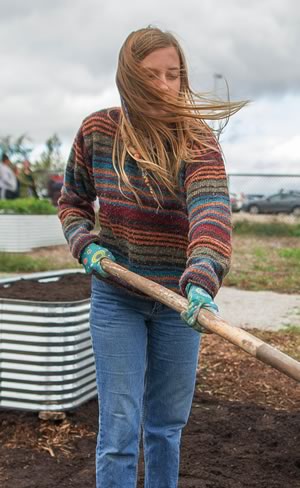
Raven Lacombe preps a vegetable bed for winter last October. Photo by James MacDonald.
Early on, speed was critical. Organizing a work bee to assemble beds and lay mulch, students broke ground on the project in mid-May last year. Choosing to plant both seeds and seedlings, they focused on early summer crops that could offer nearly immediate gratification. Some of the tomato plants were gifts from nearby schools, College Heights Secondary School in Guelph and Centre Wellington District High School in Fergus, both of which boast thriving garden projects. For inspiration, those involved in the EDHS project went on a field trip to those schools.
“The plan for the first vegetables in the spring was to plant fast crops to harvest before the end of school,” says Adrienne Sultana, who co-ordinated Everdale’s youth programs at the time. “Our small but delicious crop of veggies and herbs made their way to the food bank or the students’ homes.”
With no one around to tend the garden during the nine-week summer vacation, the team chose to plant kale, sage and thyme just as school let out. These crops don’t need much human intervention and were ready in the fall for the students to harvest and donate to the food bank. After that they planted quick fall crops, including salad mix and spinach. Eventually the garden may become more of a community plot during the summer.
Ross Watson, head of student services and the school’s environmental club, said the program is wonderful for teens interested in pursuing a career in environmentalism or agriculture. “We don’t have as many students coming from working farms as we once did,” Ross said as he looked out over the garden. “This project is a way of instilling a connection to the land that was once very common in this area and now needs to be introduced and supported.”
Tending students’ skills
Like the fast-growing garden, students’ leadership skills are also growing quickly. The project team is anchored by a core group of Grade 9 students, who meet to spread mulch, name the sunflowers and plan for the future. They are joined by Grade 10, 11 and 12 environmental science students who sometimes spend entire class periods in the garden. As it blossoms, vegetable gardening just may be the new glee club.
Indeed, principal Stephen Gayfer notes not every student is into sports, drama or music. “This undertaking allows kids to explore a different kind of passion, and to be active and to benefit from being outside and experiencing nature,” adding it’s wonderful to see this kind of active learning unfold naturally.
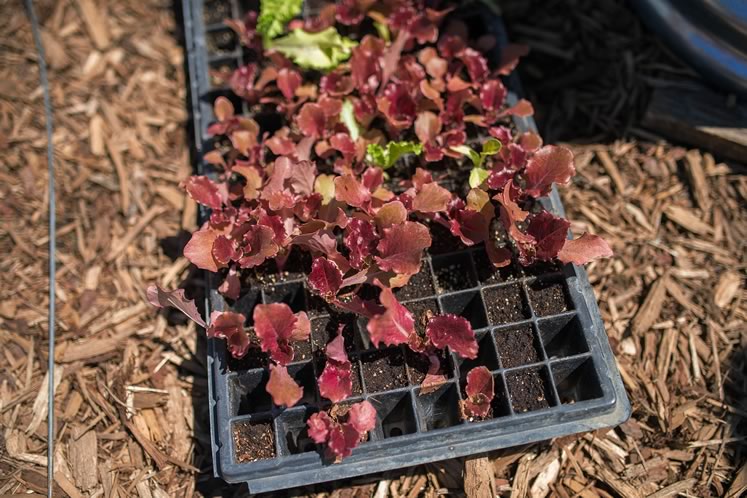
Like the fast-growing garden, students’ leadership skills are also growing quickly. Photo by James MacDonald.
For Raven, who worked last summer as a counsellor with Everdale’s farm camp program, the garden has meant much more than changing her eating habits. “It has truly shaped what I want to do with my life,” she said. “I’ve been accepted into the international food business program at Dalhousie University. That’s really what I want to do.” University may have to wait a year, however. When Raven graduates this year, she plans to do some travelling and to work as a farmhand in British Columbia to make money for her education.
Crops for credit
Some EDHS students find their happy place in the garden, while others pursue their passion for food in the school’s professional kitchen. With a strong hospitality program that gives Grade 10 students – in return for credits – a chance to cook fresh and nutritious meals for the school cafeteria, the plan is for the budding chefs to structure their weekly menu around this year’s crop plan and the availability of fresh produce. And that crop plan is now much more diverse, so students should expect to munch on sugar snap peas, carrots, beans, arugula and bok choy, to name just a few of the 2018 superstars coming when the ground thaws this spring.
“It’s truly a farm-to-table philosophy,” said Stephen Gayfer. “The difference here is it’s a farm where some schools would have a football field and a cafeteria table where hundreds of kids eat.”
An October harvest
The ringing of the school bell one day last October marked one of the last times the group met outside before the winter brought them indoors for more planning.
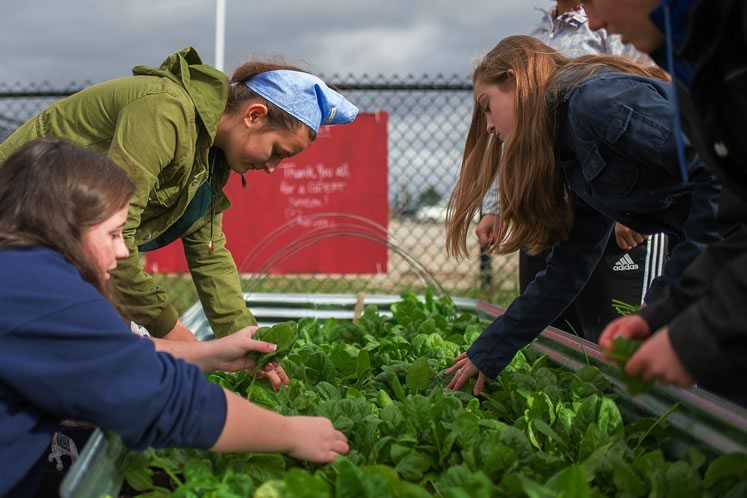
The fruits of their labour. Students April Messam, Michaela Todd, Megan Crane and Tessa Dandy harvest a bumper crop of spinach. Some will go home with the students for dinner later the same day. Photo by James MacDonald.
Among other tasks, the team had harvested vast bundles of fresh spinach. “Can we take some home?” several team members asked. One student commented that spinach is her favourite vegetable, and she planned to make spinach pizza for her family dinner that night. Karen Campbell encouraged anyone interested to pack up the greens to go. As the group ambled back to class, verdant leaves peeked out the top of many backpacks.
Green thumbs across Headwaters
Teaching gardens are blooming all over our region. Here’s a sample of other farm and school programs like the one at Erin District High School. We dig it.
Centre Dufferin District High School, Shelburne
The hospitality program focuses on nutrition, menu planning and food preparation with a college prep stream for those who see this as a career. Students can earn their Smart Serve and Safe Food Handler’s certifications, a bonus when looking for summer jobs. ugdsb.ca/cddhs
Herb Campbell Public School, Caledon
This school’s Medicine Wheel Garden, inspired by Indigenous traditions, features a walking path, traditional medicinal plants and steel stock tanks filled with vegetables and herbs. A Three Sisters (squash, corn, beans) patch showcases traditional farming methods. If you would like to volunteer for maintenance during the summer months, contact the school. Check out the school’s blog, complete with amazing photos and diagrams of student work at herbcampbellcommunitygarden.blogspot.ca
Erin Public School
Before they get to enjoy the new gardens at their nearby high school, Erin elementary kids build their gardening chops using the harvest from their school’s garden in a cooking club and in the classroom, with the rest going home with the green-thumbed students. ugdsb.ca/erinps/about-us
Orangeville District Secondary School
The well-established cooking program at ODSS transforms teens of varying culinary skills into confident cooks who can plan an entire meal (finally, homework help parents will be happy to provide). Their creations are also on sale in the cafeteria, offering delicious and nutritious food for a handful of loose change and a respite from the gauntlet of fast food spots lurking around the corner. ugdsb.ca/odss
Primrose Elementary School, Mulmur
Students at this country school have a very active EcoClub, supported by keen Eco-Parents, who help maintain a vegetable garden on the property. ugdsb.ca/primrose
Am Braigh Farm, Mono
Organic farmer (and former teacher) Jamie Richards is running a pilot project with middle school students from the Headwater Hills Montessori school in Caledon, where his wife Nancy Ernst-Richards teaches. This year the kids will plan, seed, plant, weed and harvest crops in a section of Jamie’s farm during a series of field trips. Students hope to cook a feast with their produce and donate the rest to local food banks. Jamie is teaming up with Jen Payne of the Farm to School Programs in the hopes of bringing the program to the public school system. ambraighfarm.com; headwaterhills.org
Farm to School Programs, Headwaters Food & Farming Alliance
Jen Payne of the nonprofit HFFA runs two programs connecting local farms to schools. The monthly Local Food Club, with 11 elementary schools enrolled, including Alton Public School and Princess Elizabeth in Orangeville, sends bags of fresh, local, often novel foods home with students and staff, complete with recipe cards and background on the farmer who grew them. All those schools, plus seven more, participate in educational workshops in which local farmers visit kids in kindergarten to Grade 6. headwatersfoodandfarming.ca/farm-to-school
Related Stories

Sowing the Seeds of Food Security
Mar 23, 2014 | | Back IssuesEverdale organic farm is at the centre of a project designed to create a self-sufficient organic seed industry in Canada.

Forever Everdale
Mar 21, 2002 | | Back IssuesIn the hills of Erin, the idealism of the sixties morphs into practical solutions for sustainable living in the new century.





